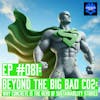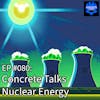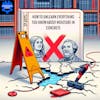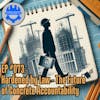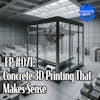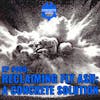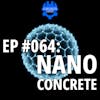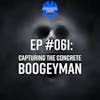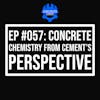EP #080: Concrete Talks Nuclear Energy
In this Concrete Logic Podcast episode, Seth and Dan discuss nuclear power and its connection to the concrete industry. They address public perception of nuclear power, the efficiency of nuclear energy, and the challenges of other energy sources like hydroelectric, wind, and solar power. They also explore the concerns about nuclear power, including waste management and accidents. Dan explains the storage and management of nuclear waste and highlights the potential of future reactor designs that can reuse waste as fuel.
Overall, they emphasize the importance of clean and efficient power generation for society. In this conversation, Dan McCoy and Seth discuss the potential of small modular reactors (SMRs) and their application in data centers. They address concerns and misconceptions surrounding nuclear power, highlighting its safety and waste management capabilities. The conversation delves into the efficiency and potential of fusion energy, emphasizing the need for continued research and development. The advantages of SMRs, including their scalability and rapid deployment, are discussed. The conversation concludes with a reflection on the importance of critical thinking when consuming media.
Takeaways
- Nuclear power is an efficient and clean energy source.
- The public perception of nuclear power has been influenced by past accidents and the misinformation surrounding them.
- Nuclear waste is a manageable issue, with current storage methods containing a relatively small amount of waste.
- Future reactor designs offer the potential to reuse nuclear waste as fuel, increasing efficiency and reducing waste. Small modular reactors (SMRs) offer a promising solution for power generation, particularly in data centers.
- Nuclear power is statistically proven to be the safest and cleanest form of energy.
- Small modular reactors (SMRs) offer advantages such as scalability and rapid deployment.
- The United States Navy's successful use of nuclear power demonstrates its safety and reliability.
- Critical thinking is essential when consuming media to ensure a well-rounded understanding of complex topics.
Chapters
00:00 Introduction and Podcast Support
03:08 Public Perception of Nuclear Power
04:21 Nuclear Power and Concrete
06:15 Power Generation by Steam
07:15 Efficiency of Nuclear Power
08:14 Nuclear Energy and Mass-Energy Conversion
09:12 Uranium and Nuclear Energy
10:12 Nuclear Accidents and Death Toll
13:01 Hydroelectric Power and Environmental Impact
14:14 Challenges of Wind and Solar Energy
15:22 Importance of Power Generation for Society
18:04 Concerns about Nuclear Power: Waste and Accidents
19:12 Fukushima Accident and Water Release
21:34 Storage and Management of Nuclear Waste
23:00 Future Reactor Designs and Waste Reuse
25:28 Small Modular Reactors (SMRs) and Data Centers
29:02 Addressing Concerns and Misconceptions
31:08 Benefits of Reactors in California
33:03 Efficiency and Potential of Fusion Energy
36:24 Safety of Nuclear Power and Comparison to Other Energy Sources
40:45 Advantages of Small Modular Reactors (SMRs)
43:13 Nuclear Power in the Navy and Public Perception
45:06 The Importance of Critical Thinking in Media Consumption
***
Did you learn something from this episode? If so, please consider donating to the show to help us continue to provide high-quality content for the concrete industry.
Donate here: https://www.concretelogicpodcast.com/support/
***
Episode References
Guest: Dan McCoy | R.L. McCoy | danmccoy@rlmccoy.net
Guest Website: http://www.rlmccoy.net/
Producers: Jodi Tandett, Jace Stocker, Gregory Rice
Donate & Become a Producer: https://www.concretelogicpodcast.com/support/
Music: Mike Dunton | https://www.mikeduntonmusic.com | mikeduntonmusic@gmail.com | Instagram @Mike_Dunton
Host: Seth Tandett | seth@concretelogicpodcast.com Host LinkedIn: https://www.linkedin.com/in/seth-tandett/
Website: https://www.concretelogicpodcast.com/
LinkedIn: https://www.linkedin.com/company/concrete-logic-podcast
[00:00:00] Seth: Welcome to another episode of the Concrete Logic Podcast, and I have Dan McCoy back, shot. Dan, you're back. Unbelievable. Yeah, Dan with RL McCoy is back with us, and today, we're gonna see I don't know how two concrete guys can talk about nuclear power. Let's see how much trouble we can get ourselves in.
With that, again, this is a value for value podcast. So there's three things you can do to help out. So I provide you value by providing this podcast. And if you think it is valuable, you provide a value back and there's three ways you can do that. One, please share the podcast with other people like us.
There's more people out there like us, right? Dan. Oh,
[00:00:48] Dan McCoy: We want to hide our enthusiasm for concrete lights though, they know we geek out on this stuff. Oh yeah. Help, help your man out if you're a woman listening to this and you're working in a professional organization, you know that you've got that special man in your life that would rather listen to this than watch football.
Oh, yeah,
[00:01:07] Seth: Yeah, that's a good idea. I like that idea. The 2nd way, so the 1st way sharing the 2nd way is you can go to the concretelogicpodcast.com website and you can reach out to me a couple of ways you can hit there's a contact button on there that'll email me, or you can hit the little microphone.
If you're Feeling like you want to leave a voicemail and I'm just looking for topic ideas or guest ideas. Most of the folks that come on this show are ideas from listeners or past guests, including Dan himself. Mr. Belkowitz or Dr. Belkowitz is our connection. So that's how Dan and I connected.
Thank you, Dr. Belkowitz. Appreciate it. And then the third way is a donate, a donation. Running a podcast does cost money. It's not a free thing. We got software and hardware and things like that, that it takes to headphones, microphones, these sort of things. It sounds like we're professional.
We're not professional, but we want to sound like we are. So if you want to go to concrete logic, podcast. com, hit the donate button and you can give any amount, any, so whatever you're feeling you're willing to donate to the show. And every amount. Is appreciate it. All right, Dan, let's talk about nuclear power.
You've you you've mentioned it a couple of times. You're a big fan. I'm a fan of it. There's a there's a, to saying something is getting pushback would be Would be saying very little about the feelings out there about nuclear power. And I think it's just because there's a there's been namely 2 or 3, 3 major disasters that have happened and the.
The way those things were covered and the information that was provided to the public about those events has really morphed our minds about what nuclear power is and how dangerous it is and things like that. But Dan, I'll let you start, and I'll just jump in where I can.
[00:03:07] Dan McCoy: Oh do more than jump in this. I was hoping this was just going to be a fun discussion about two nuclear freaks, but it ties into concrete for those of you that are like, I don't want to talk about nuclear power. I'm talking about concrete. It ties in. 1 of the greatest and most abundant sources of supplementary cementitious materials is fly ash.
And flash does a lot of great things for concrete in significant quantities. It reduces alkali silica reaction. It is a cheaper alternative to cement. It's a byproduct. So it's a usable byproduct that we can use. But in the green movement, as we're seeing. What, where you get fly ash from is from your coal plants your coal fire furnace burning.
And it is, the reason it's used is it's incredibly cheap. It's incredibly cheap. It's incredibly inefficient in terms of coal usage. But compared to the other things you can burn coal is very good. So if you, versus say, wood. Burning timber to produce, but when we talk about electricity in the grid, just to put everybody on the same page here, all you're doing.
All you're doing is taking the age-old fact, it's really old technology. You just need to spin a piece of metal around a magnet, and you create electrical current. So how do we create that continual spend? And the best way to do it thus far, or we would have created something else. Is to create a fluid that pushes this turbine around and around, you see it in hydroelectric dams where they use the natural head pressure of the water as they release that water comes through.
It spins a turbine around, which spins this piece of metal around a magnet and boom, you get electricity. So another way to spin it is to almost what everyone uses in power generation. Is a basic steam. You use the differentials in pressure between steam and the open atmosphere.
And as that steam is released. It produces that spinning motion through the turbine and it creates electricity. There are then that's when all the power separates on that side when it comes to generation. So you can use coal fire plants. A lot of those are now being transitioned into natural gas, which is a lot cleaner.
And, or even clean coal technology, but natural gas, another one that's out there is a natural gas plus nitrogen combination, but it's think about it. Everybody just think of it. It's a way to basically turn water into steam. That's what we're doing and by far, if you're looking for clean. By far the most efficient is nuclear bar none.
It is the most efficient. Because, if you look at it as every day, a coal plant requires about an entire train load of coal whereas. A nuclear reactor could take about a half of a single car from that train, load a single car and run on that uranium for a year. In terms of efficiency, that's basically what you're doing.
You're right. Seth. It's gotten so much blow back. But I think what we. What we forget is, power generation by steam has been around for millennia. Really, they've been using it to do, maybe not make electricity, but they've been using it as an engine or as a motive of getting work done for that long, and it wasn't until Einstein's miracle year in 1905 that somebody said, hey, we can convert us into energy.
We just have to hit it hard enough. In simpler terms. When you take a look at the forces of nature as they get stronger and stronger, you've got the force of gravity in the universe and then you've got electromagnetism and then you've got a weak nuclear force and strong nuclear force.
And if you're able to separate atoms. You're talking about a massive amount of energy. And that's the power of nuclear energy. It just gets it took another 30 years. Before Enrico Fermi decided, I think there's something here. He put a massive amount of uranium. And people should know that naturally existing uranium 235, or excuse me, 238.
That is the abundant amount of uranium and where is uranium created? It's a huge, massive super notice. The bigger the supernova, the heavier the element gets, and it creates a little bit of this uranium, this really heavy metal, this uranium 238. And then as it lands on earth and it exists in nature, there are a few little atoms in that big chunk of uranium 238 that are uranium 235.
And it's a very small percentage, something like 0. 7. 0. 7 percent of this big pile of uranium 238 has uranium 235, which is the fissile material that we really like because it's easy to separate from when you shoot a proton or excuse me, a neutron. And so one of the 1 of the great benefits of nuclear energy is the fact that we're continuing our advances, and you brought up the 3 scenarios.
Let's just talk about them. We've got 3-mile island. Which happens now we're taking up nuclear accidents that happened previously to that. And. But if you take total death toll and total environmental statistics from all of them. It's. I think the only one that's really cleaner so far, maybe as hydro as far as impact to, to, to humans, not so much on the environment, what you find, but if we look at those accidents that happened in the early days, and usually they were related to the Manhattan project,
[00:09:00] Seth: I would just pause there for a second. I would say the hydroelectric. Impacts people. Actually I've seen, I've read things where it impacts as far as Negatively impacting people. Hydroelectricity has impacted more people than nuclear power. Recently, wasn't it was it Ukraine that had the, or am I messing that up?
There, where was the dam that,
[00:09:27] Dan McCoy: Failed? Yeah, they, yeah, they failed that dam, which was a large, it's one of the things that, in military strategy that you always go for, communication, and then the infrastructure, especially power generation.
If you knock out the enemy's ability to communicate and then produce power to fix your communications you've effectively made them dumb and blind. But yeah, no you're 100 percent right. You're capturing, nothing's free, folks. So all this energy that you get, even if it's hydroelectric, what do you, you're taking that natural in what we call hydrologic terms that natural head.
There's potential energy there. That's a lot of potential energy. Yeah. You get it when you spill a glass of water. You spill a glass of water, you think you make a mess. Open up the hole in an earth dam. That's that has about, a couple million gallons is even the right word. These reservoirs are enormous, but that is a lot of existing pressure head and a lot of flow coming.
Yeah,
[00:10:23] Seth: that takes up a lot of land area, a lot.
[00:10:25] Dan McCoy: of land takes up a lot of planning and a lot of resources. The 3 gorges dam in China is 1 that, they evacuated, not evacuated. A domain is the wrong they displaced. They displaced a lot of people to create the reservoir that.
[00:10:42] Seth: powers that hybrid.
Yeah, and the environmental impact to just nature and animals and all that other stuff related stuff to I think people Don't consider that as well with hydroelectric.
[00:10:57] Dan McCoy: No. And, yeah that, that is a big one. I think and the, and there's probably people out there saying what about wind and solar?
I, hey, I like wind and solar. I just know that the sun isn't always shining, and the wind isn't always flowing or vice versa. You have your main load, your base load, that's the term they use in the grid. You have your base load. That's the that's the power plant that makes.
All the power, not all the power, but that's your base load pile. And then everything else comes from that, the supplemental energies of wind and solar. And one of the biggest problems I've had, I read a book oh gosh, I read a book about the grid. Oh, and I wish I could give the author credit. Dang it.
But one of the biggest problems they had with wind was they had a windstorm coming through a valley in the upper northwest, and they already had baseload power on. But it takes a while to shut down baseload power. They actually had a problem with the grid creating too much electricity that couldn't be used.
And it's the inability to control things like that. That I think could get us into trouble because all you need is to take several sections of that grid of substations out. And you've got a lot of problems for a lot of people real quick. You realize that if you're sitting in a room right now, if you're driving down the road, and you're looking at lights, you have to realize.
That at the speed of light, that light photon that just interacted with your eye was literally made in a power plant less than a second. So you have to realize how fast the speed of electricity is. And how delicate that is. If it's interrupted. That's one of the things they teach us in school.
When you're going for civil engineering and kind of braggadocious, but it is true, the difference between a third world country and a first world country civil engineer if you don't have a clean power to start with it doesn't even have to be clean in a third world country, but if you don't have power you don't have things for water filtration or even getting water or treating sewage septic.
And then that goes on to construction and building infrastructure for surface transportation. If you don't start off with those basic things and that basic freedom to have Eligibility to tap into that. You're still going to be a third.
[00:13:10] Seth: world country. Yeah. As energy goes, your society goes. China and India know that right now.
That's why they're building all the coal plants in the world that they can.
[00:13:21] Dan McCoy: They're building, they're doing everything. They're building coal, they're building natural gas. They're building nuclear reactors. Yeah. And
[00:13:29] Seth: that's where all of our calls going right now is over there.
[00:13:32] Dan McCoy: I wish we would be like; I think total 3, 3 just came online a year ago and that's down in Georgia. Yep. Boy, what a great project, but that's a full-blown reactor. Yeah. So I guess I would want to know, what are the normal things that people tell us about nuclear energy that they're scared of?
You
[00:13:53] Seth: want me to tell you, cause I know I get,
[00:13:56] Dan McCoy: I want to answer those.
[00:13:58] Seth: Yeah so, I, so folks that subscribe to the Concrete Logic newsletter will know that I write about things that I read about nuclear power and energy, and so when I do that, I do get responses. About that, they either agree or strongly disagree.
The issues that I've seen, or I've been emailed about is the waste, what do you do with the waste? And then, of course, they talk about all the people that, in people's mind there's been a lot of people killed by nuclear power. So we, you started talking about it, but, oh, geez that those are the 2 big things that I hear is waste, what do you do with the waste?
What about all the people that have been killed by nuclear energy
[00:14:48] Dan McCoy: accidents? See that's exact, exactly. Usually what you hear from people. So if we have, I think.
[00:14:59] Seth: So the last one that's prob that folks have talked about the last accident. I guess we could start with the accidents is the Fukushima accident from the to the tsunami. . What's interesting is, I think. I think everyone's on finally got to the point where everyone agrees only 1 person was killed in that disaster.
And what's interesting is this, the latest thing I've read about, it was about all the hoopla about how they're releasing all the water from the facility into the ocean. And people are all up in arms. How are you doing? Why are they being allowed to do this to release this water that was used in this facility in this nuclear reactor?
Why are they able to release it in the water? And, if you actually read and dig into it, the water that they're releasing into the ocean, I think, am I saying right? They're releasing it to the ocean is actually cleaner than the water that you would get out of your faucet. That's how that's the extreme, efforts that the Japanese are taking to release this water. And they're not, it's not like they're dumping it all at once. They're trickling it out. It's
[00:16:21] Dan McCoy: Trickle back is they could dump it all at once, totally unfiltered and the ocean would eat it up so fast that you wouldn't have any idea what happened.
The amount of dilution. I don't mean to be totally negative and poo. But that's the difference. You think as a civilization that we're really big, 8 billion people, you could fit all of us in one County in California. If we stood. So we really don't have as big of an impact as I think that people think we do mother earth will be here long after we are.
Yeah,
[00:16:52] Seth: we can get into that. I had that argument. I had that argument the other day with somebody that's another podcast.
[00:17:01] Dan McCoy: So I'm interested in, okay, let's go right down the, I was fortunate enough. Last year I took a tour of the Cook Nuclear Facility up in Michigan, which is just north of me.
And as, as a nuclear freak it was like, I was mind boggled. I just love this. And if you're a construction freak, go to a power plant. You want to see some big industrial stuff. Wow. Wow. Anything you've done, take it times ten, and that's the smallest component there. , first of all, we talk about waste.
And the Yucca Mountain debate, which was in Nevada to store nuclear waste that shut down. What these nuclear facilities do is they store this nuclear waste on site. And I would encourage you to go to Google Earth anybody listening and go to a nuclear facility and what you will see is where they store their nuclear waste.
And what you're going to be surprised with is how incredibly small the amount of waste there is. This specific one at Cook you can see on Google Maps just south of the facility, there's what looks like a football field. And inside it are containment vessels inside this football field that are about 10 foot in diameter and about 20 foot tall.
They look like little silos. And you can see that there's probably only about 20, maybe. Those two reactors have been online since the early 70s. And that's the total amount of waste produced. Since the early 1970s. That's total everything. Every bit of waste that you see is right there and you look at it and it's almost you look at it and you think that's pretty insignificant.
And that's the total amount of waste and it's set there to cool off the contaminated materials. If you take a look at the really dangerous. Materials that are highly radioactive, total amount ever made by man wouldn't even fill, half of this one. I realize I'm, I'm making light of this, but I just feel like when people hear this or hear about nuclear waste, they think it's just this huge amount belched out all the time.
And it's not, you're producing steam and you're producing this electricity naturally. Free from deleterious materials released into the air. All of it is contained within the reactor vessel. And then when the fuel rods are spent, they take the fuel rods and then they cool them in a pool for several years.
And then once they're done, they put them in storage containers. After they've cooled, they continue to air cool them. But the dangerous materials are taken out of them. The severely dangerous materials are taken out of them. And then the nuclear waste from the fuel rods that basically don't have any power left in them anymore.
We can get into future reactor designs, but most of what we're doing now is generation one and generation two reactor designs, these are designs from the 1950s and sixties folks. Enrico Fermi made the first reactor, which was a research reactor in Chicago in 1942. When you consider that most of these designs, even Fukushima in the West, let's keep it, let's keep it real, in the West, these generation one and two designs are from the fifties and sixties.
We've, there's nuclear engineers out there and physicists that have come up with way better ways to split an atom than what was done in the 1950s and 60s. But every time, it's brought up they're pooh poohed about the dangers, but if you go to generation three or generation four type reactors, we're talking about them taking that nuclear waste and actually reusing it the reactor as an additional fuel to get more energy out of and there's passively safe reactors.
There's now reactor designs theorize that you don't have to shut down because you use nuclear pellets. You create these pellets coming through a funnel. And then once the energy is drained, the uranium is drained out of that pellet, it simply drops out and goes to storage. You don't have to shut down an entire reactor to replace fuel rods.
Oh, that's cool. So many advanced designs. I'm most excited about, there's a company called NuScale. Yeah. So have you heard of NuScale?
[00:21:05] Seth: If you're following nuclear energy news, it's there, the it was the last fall that everybody was saying they, cause they shut down one of their projects at, nuclear powers over or something.
It was some hyperbole like that. I can't
[00:21:19] Dan McCoy: remember. I think the SMR, so people look into it, the SMR, the small modular reactors, that will be the wave of the future. I really liked the way they think out that plan about creating a modular reactor that's self-contained. In a municipality or local utility could buy it.
And then you stack them up in banks, almost like a battery bank. And then if one needs maintenance, you can always have nine others online and you're creating a total amount. If you do 12 of them of, about a thousand megawatts. If you've got them online.
[00:21:50] Seth: Yeah. What's really interesting in the industry that's talking about this stuff right now is data centers.
So right now the problem with data. Data centers are getting power to them. They use a
[00:22:01] Dan McCoy: lot of electricity. Yeah. Yeah,
[00:22:03] Seth: they usually yeah, definitely. So they're talking about in the future, having these small module reactors is using these on a data center facilities, and they'll be able to, like you were saying, Dan, is you can start with one and then add to them as you need them, versus the way.
The thing that's slowing data center construction down right now is getting the power there first. Cause that's what needs to be there first, right? To get the use of much energy. Microsoft there was it was I think, yeah, it was Microsoft. They posted a job opening for nuclear energy or whatever they call it, I forgot what that was called.
And that went all over, at least in my circle of what I follow. It was all blasted all over the place and everybody's Oh, look, Microsoft's into it. So I think we're seeing some, maybe fringes of the industry lean towards lean into nuclear power. We just got to figure out what's the best way to do that.
Because you're not going to power data centers with a wind turbine or solar panels. And we truly don't know the. I don't think we truly know the negative consequences with the wind turbines and the solar panels yet. I don't like those 2 sources of energy because I'm all into efficiency and those things aren't efficient to me.
They take up to too much land. Mass to do those things, and I think they're ugly. I don't want to look at them. I don't want to see them. That's a really good reason. Yeah
[00:23:37] Dan McCoy: superficial, but it is, if it becomes part of it, but on the other thing, what are we going to do with them when they're done?
Yeah they're waste. Like I said, everything that I've 1 react to reactors from the 1970s fits inside a space. That's half the size of a football field in cylindrical tubes that are 25 feet away from each other. Yeah, that's the total amount of waste, but you start talking about what's going on with solar panels and how we're going to recycle those.
I don't know what we're gonna be, looking at.
[00:24:11] Seth: Yeah, with the, again, subscribers to the concrete logic newsletter will know I shared with them. It's been some months, but down in Texas, there's a town that somebody talked them into doing this. Some business or whatever that recycles wind turbines has it's just acres and acres of these wind turbines that are either broken or used or whatever.
And they're supposed to recycle them, but they don't know how to recycle them. So they're just stacking up over there and the town's going crazy. They're like, we don't want this stuff in our town. So yeah, it's, it, yeah, to me, these things, like you said, though, there's tradeoffs. There's not a perfect, there's not a perfect answer.
I'm not saying nuclear power plants are the most beautiful thing to look at either. But I think. Instead of investing the billions and billions of dollars that we're dumping into solar energy and wind power. I just, I think that money is better spent on nuclear power. We could figure out how to address the things that people are most concerned about with nuclear power with that money safety and waste management and things like that.
I
[00:25:26] Dan McCoy: look at sometimes I hit myself because I think about California. And I think what a perfect place for reactors, right? We, they have a power shortage out there. If you put reactors in, you place it next to a coastline. Similar to Fukushima, I don't want to make anybody panic, but if they know the details by Fukushima, every 1 of those errors.
Has been accounted for and fixed in future designs and it was mainly. The effect of an earthquake, a record-breaking earthquake with a record-breaking tsunami. Drowning out the backup diesel generators. That was basically the whole problem. That's been fixed in every reactor around the world. The backups that have been gone into that.
But if you look at a state like California that constantly has grid problems, constantly has outages and brownouts, you could solve a lot of problems with the reactor not only in power, but they also have a problem with water. One of the greatest things that you can do with the additional power that you make from a reactor is run a desalinization plant.
You can literally make drinking water out of the ocean. They, they have this there's always freshwater shortages out there and the South Plains, the North and the agricultural district, they're using all the fresh water, but it's you need food, don't you?
You need farmers. I'm pretty sure I might be making a mistake here, but I'm pretty sure California might be it's at least in the top five, if not the top one or two for agricultural and production in the United States. I think a lot of people find that surprising. There's a huge farming community out there and it does take water to grow things.
But you hear these things about we can't have a desalinization, but that'll take 20 years. I heard that 20 years ago, and if you would've started then you would've had it now. It's, you think about those things, and it takes power to run those things, but you also need, if you're running and reactors are most efficient when they're running at high output.
So now you've got in the nighttime when maybe you're not using all the industry you don't settle the reactor down, you use that baseload power plus whatever it's making to run your desalinization or in more rural areas without saltwater in, in the country, you use it for hydrogen generation and you produce hydrogen gas, which is another incredibly useful fuel that a lot of people are afraid of for some reason, I think since the Hindenburg disaster, they were really afraid of it.
But anything that burns can create energy, there's that potential chemical energy involved. And I just, I wish people would get past the stigma and really do the research and not believe everything they hear about the nuclear industry. We mentioned right, Three Mile Island Chernobyl.
And then we've got Fukushima Three Mile Island, that was a personnel error, a training error about, about being stuck open when they didn't believe the computer said the valve was stuck open. It went into a meltdown scenario, the containment vessel trapped everything. This was the worst of the worst scenario, and it was all contained within the reactor vessel, and then the house.
That's like the worst you can get, and that's what happened in the United States. Chernobyl, Russian standards were a little bit different. The reason those that RBMK reactor was so immense and huge to create 1200 or 1500 actually that was a 1600 megawatt reactor. They use lower enriched uranium, right?
Because it takes energy to enrich the uranium to a point where you get a fissile material out of it. We look at ours as between, I say, what's fuel grade for us. Somebody's out there screaming at me, but it's seven, 10%. And the Russians use like 3%. So it takes that much more volume to create the same amount of energy.
And., they didn't put as much energy in enriching that more than likely, they kept enriching it to make weapons great. But the reactor itself then was simply, if you ever look at pictures, tell somebody to go look at pictures of Chernobyl, there's no concrete secondary containment.
It's in an open building that you would see on your grandpa's farm if you just put a new pole building up that's what was there Surrounding the reactor vessel. Wow you don't have a containment vessel or reactor containment vessel for that and then everything else that went wrong with it You know, it was a graphite moderated reactor Which is great for slowing things down and making that reaction pretty efficient But when it's run away and you produce all those toxic, bad things, the solar reactor down, if they catch them up real quick, that's what you get is an immense amount of power, incredibly quickly.
Not so much an explosion. But I know there was an explosion related to the hydrogen that came from it and the same thing at Fukushima, but then again, it was designed to do that. You have a hydrogen leak and it's meant to belch that out. And if it catches fire, it still doesn't reach the containment vessel.
That you see around these reactors and it's interesting that you say that about Fukushima because there was a college study that was done where they were their dosimeters. From the moment they got to the airport, flew over to Japan, toured the site, and then flew back, everybody looked at the data from the disseminators, and they realized the highest exposure to radiation they have was when they were at 35, 000 feet in the airplane.
Yeah. You can't make this stuff up. And that was standing at ground zero of Fukushima. So there's some misnomers about it that I don't really like. And I feel like if we spent more time working a problem, we would get to a better solution. Fusion energy's out there now to make it work.
When you. People that do that idea, I think all you need to realize is the sun's a pretty big thing. I think this might be controversial, but I believe that the burning orb in the sky has a little bit to do with global temperatures. When you consider that in, in that. Nice fusion reactor that we call a sun.
It makes more power in a second than the human race has ever used. And I realized that's really attractive to the solar power folks. So you realize the broadband of energy that we get eight minutes away from it is just light energy, the truly most inefficient form of the energy that it creates you realize how.
Big of the deal that a fusion reactor and they've created it in the lab that JPL and it matches Surprisingly enough it matches the first efficiencies that Fermi got with a fusion or excuse me with a fission reactor efficiencies are incredibly low and then they get better and better over time.
We're talking about efficiencies that are in the single digits up to 13 or 14 percent and even now the greatest power plants that we make, the most efficient that we can get. You're still at only 30 or 35 percent efficiency. Efficiency is one of those things that will just bite you in the end.
And people say how's that? It's everything that goes into making. How much, even when we ran the Manhattan project, I think we use like 80 percent of our nation's electricity to be able to build those or to be able to produce enough uranium 235 for the first bomb to be able to do that.
I talk to people all the time; they don't know the difference between the two bombs and the difference between that and nuclear reactor. There's a hell of a difference. Totally different. Totally different thing. You want a long prolane, prolonged chain reaction that's continual. Where in a bomb you want a huge supercritical reaction.
And you try to make it last as long as it can. They're totally different. So nuking, you can't make a nuclear bomb out of nuclear fuel routes from a reactor. I guess you could, but that's a lot more energy than you want to put into it. Yeah. Technically make, you could technically make a dirty bomb.
But the security that I saw at the nuclear facilities that's placed, not only by the private contractors, but by the department of energy, good luck. Try it but there's no way, there's no way, and then even if you got in to make a dirty bomb type scenario, there's so many fail safes there's so many fail safes that there's I, it is the, to me and it's been statistically proven, it is the safest form, and the cleanest form of energy that we can make as of now, and just imagine if we just put a little bit of time and effort into it, to do passively safe reactors, or use molten salt reactors, Generation three or generation four reactors and actually invested in those.
And that's why I'm excited about this, the small modular reactors, because we can do it on a smaller scale and then anything that we do, we can change faster and more rapid, we can expand that more rapid than we can like, say a al, which is like a, 15 year construction time and $22 billion.
Yeah. A huge, massive reactor. Yeah. 'cause that's a, it's kinda like it's built already. It was designed 20 years ago, but that was using designs that were 20 years old, and you're looking at a 40 year life cycle for a plant, which now they can extend on, they can, it's more than 40 years, but it's still an attractable option for utility companies and believe it or not, the DOE department of energy still.
You can still go out, and you can still apply for grants, and they do give a lot of money to these utilities and power producers for research on these reactors, but there is a large stop gap in what they approve, because they're so dangerous, the new regulatory regulator the NRC really gets involved with it more so hoops to jump through than any other means of power production, just because the stigma that's created with radiation and Mainly, probably the weapons usage material, but yeah I just love talking about this stuff.
I could go I, if you want to go on stuff, I, you could I just love it. Yeah. I can tell it's just so fascinating and the stuff that we could do and it's whether it's construction, whether it's power, whether it's anything, I just I like to immerse myself in it before making a brash decision making.
About it, I'd like to research and know as much as I can. And usually, nobody knows everything, and that's the beauty of it. The more you talk about it, the more you do it, the more you learn about it, and it makes you better along the way. Maybe you want to change some of the decisions that you made 20 minutes ago or two years ago.
Nobody told you to do that. Do it. You're, that's the whole point of life is to continually grow and empower yourself with the knowledge of what you need. So I hope people, if they're listening, if they didn't like, odds are if they listen to you, they probably like nuclear energy. But if they didn't like it, hopefully they thought about it and maybe got some fuel to think about for the future in conversations that they have with people that maybe don't like nuclear power.
But it's definitely one of the, everybody brings that up. But I say, the United States Navy's got a pretty good track record with small modular reactors, and nobody seems to be worried about them too much. People shoot things at them. So I so there's a little bit of evidence there that we're pretty safe.
[00:36:11] Seth: Yeah, those guys know what they're doing. Yeah.
[00:36:14] Dan McCoy: Yeah.
[00:36:14] Seth: Yeah. All right. No, we'll pause. They're definitely something we need to revisit and talk about more. Yeah. As those progress, I know here in Virginia, the governor is pushing for. For some of that to happen here and trying to invest money into it, and I think it's just, if everybody.
That is I guess that understands the potential of nuclear energy just speaks positive of it and doesn't just ignore people's concerns and try to point them in the direction where they can read information about, what is truly the history of nuclear power and how it's impacted us and all that.
And as far as the, like you said, it's so heavily regulated now, it's gotta be the safest thing to be. But yeah. So Dan, I'm going to share everybody's contact information so you can get some of the hate mail that I get about nuclear power and
[00:37:12] Dan McCoy: I welcome it because. It's not so much that they hate it, they just don't understand it.
Yeah, exactly. And that's totally understandable to not understand. And it's very complex. And there's so much news out there about this, about everything we look at. You said it the beginning. And I guess I'll, this'll be the last thing I say, but I want everybody out there to think about, you said, where you get your news source.
I would just like everyone to go back in their head right now and think about a news story. Any news story that you thought about in the last week, year, whatever, that you had intimate knowledge of? There's got to be one out there, whether an accident happened next to your house or whether there was something going on at work that was reported that you know about.
I guarantee if you look at that news story, you've watched it and you thought that's not right. That's not the way it was. Just know that every news story has someone connected to it that's saying the same thing. Journalists don't have time. To relive your experience and take your perspective on it, on that news story that you were in, but every news story to them is like that.
All they can do is get a synopsis from it and take that advice. So I would just. Just know that every news piece or news article that you hear, there's someone out there with very instant knowledge of it that is going not exactly why. And I think that's probably the best mesh mission that I can give people to do is say, look at those.
Look at what media reports are. And it's not their fault. They're out there to sell advertising and get money, and they still have to bring you the news, but they're just not as knowledgeable about these subjects. The individual subject is as any one person is that's connected with what they're talking about.
And I think you'll find, we've all seen construction stories before, and they'll say something and you're like, no, it's not. That's not why that happened. We all know that, but you have to remember, we're experts in that field. In someone else's line of work, they may be talking about something that you don't understand, but you just take their word for it because you don't understand it.
There's somebody else that's intimately connected with that story or that industry that is looking at that going. That's not exactly you have to keep that open mind every time and I'm not blaming journalism. I'm not a journalism hater. I'm just saying that if we have to write about something that we're unfamiliar with, we've got a deadline in the next 3 hours.
We're probably not going to be 100 percent right about everything that we're going into it. We've covered the facts. We've somewhat seen what's going on, but we're not intimate with the relationship that developed that story. Yeah. I think that's very fair.
[00:39:56] Seth: All right, Dan, appreciate you coming back on the show, everybody.
Until next time, let's keep it concrete.
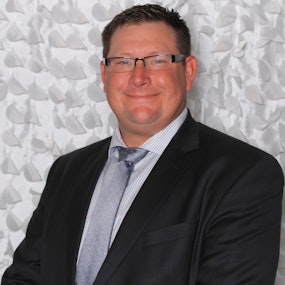
Dan McCoy
Engineer
Dan is a third-generation bridge builder, 2nd generation concrete pumper, and first-generation engineer. He has 27 years of construction and concrete experience with a passion for improving infrastructure and improving daily life (and commutes!). Dan has worked as a contractor in an experimental capacity with the Indiana Department of Transportation and Universities to seek out new and innovative means, methods and materials used in the construction industry. Most recently Dan has been a part of an initiative to improve concrete performance, workability, and lifecycle for concrete used in Indiana Heavy Highway Infrastructure by implementing changes to the design and specification of concrete as it relates to nano silica in concrete. More specifically, the uses of E5 and Liquid Fly Ash as well as other topical solutions involving nano silica. Dan is a lover of SMART infrastructure, and all things that go along with it! He is married to his wife of 18 years, Hillary, and has 3 boys that are actively trying to kill him 78% of the time.








